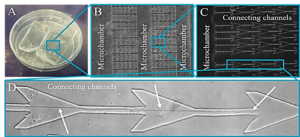The instant I turn on the news, I’m bombarded with a lot of ‘negative’ information.
As we are still in this global pandemic probably for the foreseeable future, I would like to spread some positive information and highlight a development in studying the COVID-19 which is potentially only possible in Organ-on-Chip (OoC) models.
Therefore I would like to highlight a recent publication by the group of Josef Penninger to demonstrate the power of OoC models. The group of J. Penninger was able to show that the ACE2 receptor plays a key role in the infection of cells by the virus. Furthermore, they were also able to demonstrate that human organoid models for the kidney and capillaries could serve as a great model to study the early infection of the virus by using a soluble recombinant human ACE2 molecule that inhibits the infection. However, the mouse equivalent molecule did not inhibit the infection [1]. There is to date no animal model that can recapitulate the severity of COVID-19 seen in patients [2] even after transfecting them with the human ACE2. This indicates that perhaps instead of trying to create animal models that aim to recapitulate the disease phenotype seen in human patients, using human induced pluripotent stem cells (hiPSC) to engineer tissues and organoids in-a-dish or on-a-chip could be a much better strategy. Particularly, these human based models seems to hold a much better promise of recapitulating relevant human COVID-19 characteristics for drug testing and discovery.
At the LUMC, we are also investigating OoC possibilities, not to study the virus, but rather to engineer brain-like micro physiological constructs for studying neurodegenerative diseases. As the lockdown regulations eased up, we were successfully able to optimize protocols for fabricating and seeding PDMS chips. We show an example of a multi chamber microfluidic chip loaded with hiPSC derived neurons interconnected by microchannels for axon guidance3. The chip will be used to study cortical spreading depolarization in the context of migraine.

Figure: The PDMS multi chamber chips separated by interconnecting microchannels, as shown in A-C. An example of a loaded chip with hiPSC derived neurons connecting via the interconnecting microchannel is shown (D).
[1] Monteil V. et al. Inhibition of SARS-CoV-2 Infections in Engineered Human Tissues Using Clinical-Grade Soluble Human ACE2. Cell 181, 905-913.e7 (2020).
[2] Datta P. K. et al. SARS-CoV-2 pandemic and research gaps: Understanding SARS-CoV-2 interaction with the ACE2 receptor and implications for therapy. Theranostics 10, 7448–7464 (2020).
[3] Holloway P. M. et al. Asymmetric confinement for defining outgrowth directionality. Lab Chip 19, 1484–1489 (2019).
Lastly, during this pandemic, be kind to others as well as yourself and stay safe.
Michel Hu NOCI PhD-student LUMC
